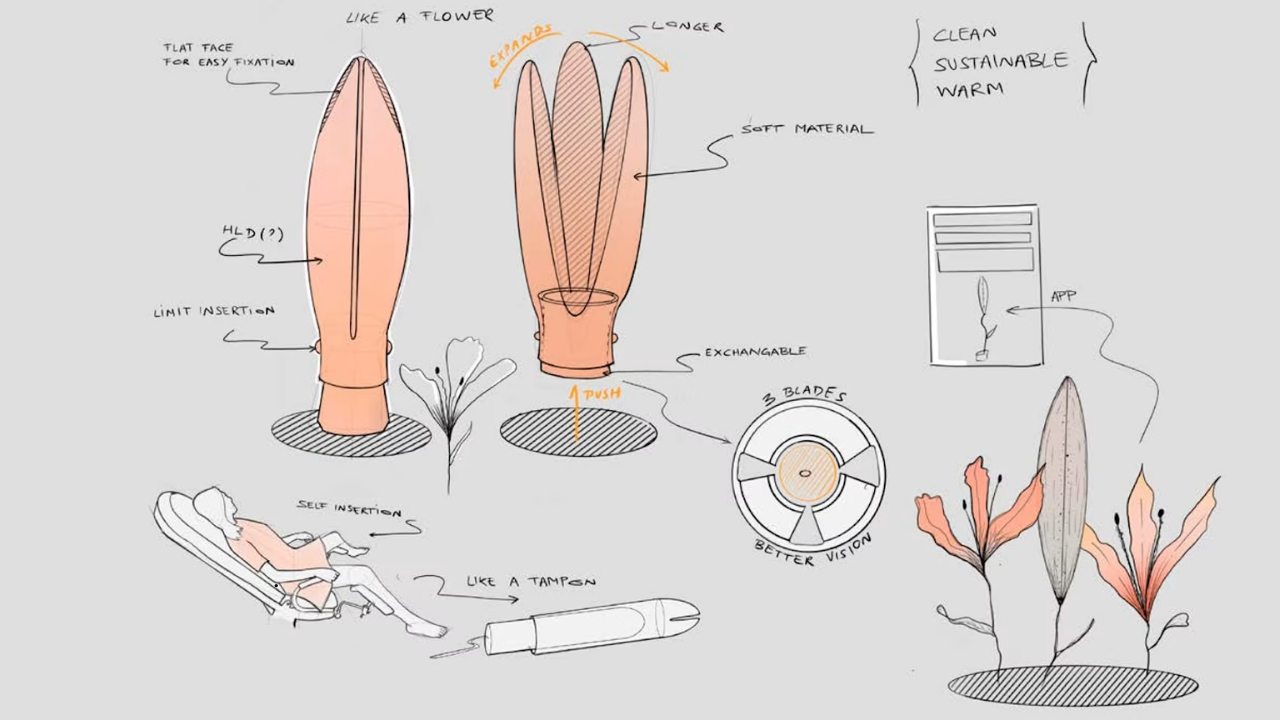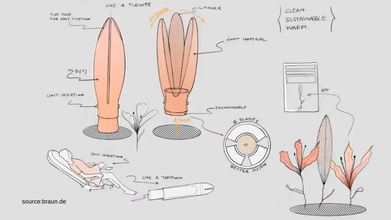- Health Conditions A-Z
- Health & Wellness
- Nutrition
- Fitness
- Health News
- Ayurveda
- Videos
- Medicine A-Z
- Parenting
180 Years After The Original Vaginal Speculum Was Invented, It Gets Redesigned: How Does The New 'Lilly-inspired' Device Ease Pain And Fear?

Credits: AFP
For nearly 180 years, the vaginal speculum has remained largely unchanged: cold, metallic, and intimidating. Invented by Dr. James Marion Sims in the mid-19th century and originally tested unethically on enslaved women, the speculum’s history alone is enough to cause discomfort for many. However, it’s not just its past that’s problematic, patients frequently report physical pain, emotional distress, and anxiety linked to the device’s design and clinical use.
While many clinicians have considered it a necessary evil, a growing wave of medical designers, engineers, and gynecologists are challenging that notion, advocating for innovation that centers the patient’s emotional and physical well-being.
The Flower That May Redefine Pelvic Exams

Enter the Lilium, a new, flower-inspired speculum design created by two engineers from Delft University of Technology in the Netherlands: Tamara Hoveling and Ariadna Izcara Gual.
Designed to resemble a blooming lily, the Lilium was conceived as a direct response to the emotional and physical discomfort women often feel during pelvic exams.
Made with soft plastic and featuring an applicator similar to a tampon, the Lilium is shaped to open like a flower, providing better visibility for clinicians while being significantly less intimidating for patients. It also eliminates the harsh clicking sounds and rigid, cold sensation associated with the traditional metal models.
“The aim was to create something familiar, symbolic of the reproductive system, and emotionally safe,” Hoveling said, emphasizing that trauma-informed design can make all the difference in encouraging routine screening.
What the Experts Say
Dr. Archana Dhawan Bajaj, Gynaecologist and IVF Expert at Nurture, strongly supports the redesign. Speaking to Health and Me, she shared how many patients, especially first-timers or trauma survivors, avoid gynecological exams purely because of how threatening the traditional speculum appears.
“It’s cold, mechanical, and terrifying. Many women skip vital preventive exams like Pap smears simply due to fear. A gentler, flower-like design like Lilium not only reduces pain but also the stigma and fear surrounding such check-ups,” said Dr. Bajaj.
She believes the Lilium offers more than aesthetic comfort, it symbolizes empathy in care. “Its soft texture, warmer material, and symbolism of blooming can help women associate pelvic exams with care rather than dread,” she added.
It’s Not Just Physical, It’s Emotional
Pain during pelvic exams isn’t solely physical. Dr. Bajaj explains that anxiety, fear of discomfort, and past trauma often make the experience worse.
“The cycle of fear leads to muscle tension, which increases pain. And that pain only reinforces the fear,” she said. “A redesign like this breaks that cycle. It helps the patient relax, trust the process, and stay engaged with their reproductive health.”
Such emotional consideration is especially crucial for survivors of sexual trauma and post-menopausal women, for whom speculum insertion can be especially distressing.
A History of Redesign Attempts
Lilium isn’t the first attempt at a redesign. Over the years, several models have tried to address comfort:
FemSpec (2005): An inflatable speculum that mimicked a blood pressure cuff. Though it got FDA approval, it was withdrawn in 2008 due to clinical impracticality and physician resistance.
Callascope: A tampon-sized device with a built-in camera for cervical visualization. It bypasses the need for dilation but still faces challenges in physician acceptance and cost-effectiveness.
Nella and Yona: Ergonomic updates to the traditional model. Nella introduced quieter operations and smoother polymers, while the Yona design, developed by San Francisco firm Frog, experimented with a 105-degree angled handle, silicone materials, and a softer, less intimidating shape inspired by sex toy design.
Despite these efforts, none have received the kind of widespread support that Lilium is beginning to garner, thanks, in part, to its empathetic approach and viral crowdfunding campaign, which raised over €100,000 in just two days.
Beyond Design: Why Empathy Matters
The redesign of gynecological tools like the speculum isn’t just about comfort, it’s about dignity, access, and trust. According to Dr. Bajaj:
“Empathetic instruments say something powerful: we value your emotional well-being as much as your physical health.”
This matters. Studies and surveys show that a significant portion of women avoid screenings due to fear or discomfort. In fact, a 2020 study found that 13.6% of women skipped cervical smears due to painful past experiences with speculums.
By designing tools that prioritize empathy and accessibility, we don’t just change devices, we change behaviors. More women are likely to attend screenings, leading to earlier diagnosis, more open conversations about reproductive health, and ultimately, lives saved.
Lilium is still undergoing ergonomic testing, human trials, and regulatory review. But its success so far is an important signal.
“This is not just about a speculum, it’s a symbol of progress in how medicine treats women,” says Dr. Bajaj. “It invites patients in, rather than scaring them off. That’s the future of gynecological care.”
News That Made Us Happy: Biggest Health Discoveries of 2025

Credits: Canva
As 2025 comes to an end, one thing is clear, this year has been a year of remarkable shifts in how we understand health. This year, there have been breakthroughs, redesigns, and achievements in the healthcare sector, which has changed many lives. Scientists and doctors have pushed their boundaries in ways to save lives, make patients more comfortable and Health and Me lists down 5 such breakthroughs that defined the year 2025.
Reinventing Speculum: The Flower That May Transform Pelvic Exams
Few medical tools have stayed as frozen in time as the vaginal speculum. Cold, metallic, and intimidating, its origin traces back to Dr. James Marion Sims in the mid-19th century, during experiments carried out unethically on enslaved women. Beyond its history, patients have long reported pain, anxiety, and emotional distress linked to it. But this year, a young design team dared to ask what would happen if pelvic exams could feel safe.

Enter Lilium, a flower-inspired speculum created by Delft University engineers Tamara Hoveling and Ariadna Izcara Gual. Made with soft plastic and shaped to bloom like a lily, it opens gently, eliminates the harsh clicking sound, and uses a tampon-like applicator for insertion. Designed to feel familiar and symbolically comforting, Lilium represents a shift toward trauma-informed, patient-first gynecological care—something long overdue.
Zaynich: India Launches Its First New Antibiotic in 30+ Years
For 28-year-old Sahil Mehra from Mumbai, a severe, drug-resistant Pseudomonas infection left his kidneys failing and his doctors nearly out of options. Even last-resort antibiotics couldn’t stop the superbug.
Then came Zaynich, India’s first new antibiotic in more than three decades. Developed by Wockhardt, it combines cefepime, a fourth-generation cephalosporin, with zidebactam, a novel β-lactam enhancer that boosts the drug’s power against tough bacteria. Early reports and trials suggest a 97% effectiveness against drug-resistant Gram-negative bacteria and even a 20% higher cure rate than meropenem in Phase 3 studies. Within four days of receiving Zaynich, Mehra’s condition stabilized—a reminder of why antibiotic innovation is essential in the age of superbugs.
A Powerful Cholesterol-Lowering Pill Could Change Heart Care
High LDL cholesterol remains one of the biggest drivers of cardiovascular disease. While statins help, many people never reach target levels. Injectable PCSK9 inhibitors work well but remain expensive and less accessible.
This year, an experimental daily pill—enlicitide—showed promise of changing that equation. In the Phase 3 CORALreef Lipids trial involving 2,912 adults, enlicitide reduced LDL-C levels by 55.8% at 24 weeks, with post-hoc analysis suggesting reductions up to 59.7%. With a safety profile similar to placebo, enlicitide could become the first oral PCSK9 inhibitor to make potent cholesterol control easier and more widely available.
Zombie Cell: A Longevity Pill From China Claims Life Up to 150 Years
A Shenzhen-based biotech company sparked global debate by claiming it has developed a pill that targets ageing at the cellular level. The pill focuses on clearing “zombie cells”—old cells that refuse to die and trigger inflammation. Made with compounds derived from grape seeds, early animal lab work suggests potential lifespan extension. While far from proven in humans, the idea that such a pill could stretch life to 120–150 years captured the world’s imagination and intensified conversations around longevity science.
The World’s First Single-Dose Dengue Vaccine Gets Approved
With dengue cases hitting record levels globally, Brazil approved the world’s first single-dose dengue vaccine, called Butantan-DV. Developed by the Butantan Institute in collaboration with Wu Xi, it uses a live attenuated virus and is currently approved for ages 12 to 59. Until now, the only dengue vaccine required two doses months apart. This single-shot version could transform dengue prevention, especially in tropical countries facing surges linked to rising temperatures.
Unique Symptoms Of Norovirus In 2025 And How Long Does The Infection Last?

Credits: Canva
Recently the news of Norovirus outbreak in an AIDA cruise that has infected more than 100 guests and crew on board made news. This is the 21st outbreak, as confirmed by the Centers for Disease Control and Prevention (CDC). This case has brought back memories from the Royal Caribbean Cruise outbreak, where 94 out of 1,874 and 4 crew members also were infected by Norovirus.
This virus is also known as the 'rib-cracking' winter virus, which sets it apart from rest of the winter viruses. People who have been sickened by this contagious virus are vomiting explosively, which may make the sufferers to experience a cracking in their ribs, which is where it gets its name 'rib-cracking' winter virus.
What Is Norovirus? What Makes It So Unique?
The virus typically spikes after the holidays, when families gather indoors. However, new data from the Centers for CDC shows this year’s surge has arrived weeks ahead of schedule, and experts say there’s no obvious explanation yet.
According to the CDC, 12.5 percent of norovirus tests came back positive during the week of November 22, nearly identical to the 13 percent positivity rate the week before. Compared to two weeks earlier, infections have jumped by about 25 percent. But the real number of cases is likely far higher, as most people with norovirus never get tested.
Between August 1 and November 13, health officials recorded 153 norovirus outbreaks, more than double last year’s 69 during the same period, and far above the 65 reported in 2023.
The CDC estimates the U.S. sees around 2,500 outbreaks every year. An outbreak is recorded when two or more people fall ill from a suspected or confirmed shared source.
On cruise ships, which are closely monitored by federal agencies, outbreaks have also been climbing. The AIDAdiva, a German vessel currently on a long global route, recently reported a spike in cases. In a statement to USA TODAY, AIDA Cruises said it has increased hygiene measures on board and that infections are already declining.
“Seasonal illness peaks between November and April, and the AIDAdiva report reflects what we’re seeing on land,” the cruise line said.
Why Norovirus Hits So Hard
Norovirus infects roughly 21 million Americans every year and sends about 2 million to hospitals or clinics. It spreads easily through contaminated food, surfaces, shared utensils, or direct contact with an infected person. Even a tiny amount of virus can trigger illness.
Symptoms usually appear within 12 to 48 hours and include nausea, vomiting, diarrhea, stomach cramps, and sometimes fever and chills. The biggest danger is dehydration, which can set in quickly. Severe fluid loss can lead to low blood pressure, reduced organ perfusion, electrolyte imbalances, and in extreme cases, seizures or fainting.
The virus contributes to about 900 deaths in the U.S. annually, mostly among older adults.
Doctors emphasize that hand sanitizers don’t reliably kill norovirus. Frequent handwashing with soap and water is the best protection.
The season’s lowest positivity rate was recorded in early August at 6.5 percent. But with holiday travel and gatherings underway, health officials warn infections are likely to rise.
What Are The Symptoms Of Norovirus And How Long Do They Last?
- Nausea
- Vomiting
- Stomach pain or cramps
- Watery or loose diarrhea
- Feeling ill
- Low-grade fever
- Muscle pain
The symptoms usually begin 12 to 48 hours after your first exposure to the virus and could last from 1 to 3 days. You can, however, continue to shed virus in your stool for several week after your recovery. The shedding could go up for months if you have another medical condition.
Connection Between Migration And Pollution: People Are Leaving City To Be Away From Delhi's Toxic Air

Credits: Canva
Delhi woke up again to a thick layer of smog, with Delhi's AQI hovering over 300 on the Air Quality Index on Thursday morning under "very poor" category. After a long nine-day wait, city's AQI had slipped under "poor" category on Tuesday, but it is again back on the "very poor" category, while on Wednesday, there were strong winds that dispersed the pollutants. Yet the condition of the air quality remains bad.
As a result of this many people are leaving the city, or have at least considered leaving the city.
"I Felt Breathless And Constantly Fatigued"
Nikita Singh, 31, who runs a remote PR boutique agency was living in Delhi on and off for two years because it was two years back when she struggled to breathe during Delhi winters. "The pollution levels were so extreme that I felt breathless and constantly fatigued. That was the first time I seriously questioned whether I could continue living here long-term," she says.
For the first two years, she kept "oscillating". "I would stay in Delhi for work during peak months, then leave when pollution became unbearable, especially from November to January. Every return felt heavier. I had my eyes burning, headaches, chest tightness and a general feeling of 'I cannot do this forever'."
She has now permanent moved away from Delhi to Jodhpur, in Rajasthan, where she works remotely. However, it has not been easy on her. "Emotionally, it was tough because Delhi had become familiar, and my life and work circle were mostly based there," she says. However, thanks to her fully remote work and that fact that she had decided to prioritize her health, she was able to make the move.
She says that Jodhpur offers the cleaner air which she "never felt in Delhi". Her decision to move also came with her family uprooting from Delhi. "My family and I shifted together. AQI was a major trigger. We realized we could not keep exposing ourselves to those levels of pollution year after year," she reveals.
Migration And Pollution: More Delhiites Are Considering To Move Out Of The City
She is not alone, Vikash Makkar, a freelance linguist specialist and a journalist, who had been living in Delhi from the last 12 years, moved back to his hometown in Jamshedpur. "Since October with an unplanned journey, I moved to my hometown and have been living there. It is quite relaxed here as compared to Delhi's ongoing pollution crisis that I had faced," he shares.
29-year-old Riya Baibhawi also uprooted from the city. She had been living in Delhi from last 5 years. She is currently living in Ludhiana, Punjab, and her decision to leave city is also affected by the pollution. Though, it was not easy for her. "It was very tough because it was very difficult to find career opportunities with competitive salaries outside Delhi-NCR. It also required a cut down of my social life, which adversely affected my mental health," she says. She shares that one of her friends, who had been living in Noida for the last 20 years had also moved out as pollution exacerbated her asthma.
Another family, who have been living in Delhi's Karol Bagh for more than two decades now are considering moving out of Delhi. "They are looking for properties outside Delhi where air is cleaner," shares their 26-year-old daughter who now lives in her marital home in Noida.
As per a survey by a consumer insights platform Smytten PulseAI, about 34.6% of the residents surveyed in Delhi NCR have considered to move out of the city due to worsening air. A 2023 study published in the International Journal of Environmental Research and Public Health shows that if the level of PM2.5 increases by 10µg/m3, migrants coming into the city will be reduced by 21.2%. While migration in the city has been ongoing, pollution does show some strains of people moving out of the city.
As per the Air Quality Life Index released by the Energy Policy Institute at the University of Chicago (EPIC), the fine particulate matter or PM2.5 in air will shorten an average Indian's life expectancy by 5.3 years, and in Delhi, it could shorten a person's life span by 11.9 years. However, the Union government has said in the parliament that there is "no conclusive national data to establish a direct correlation between deaths or diseases occurring exclusively due to air pollution". This statement comes at a time when doctors themselves noted a surge in cases due to pollution and have urged people to leave the cities.
© 2024 Bennett, Coleman & Company Limited

